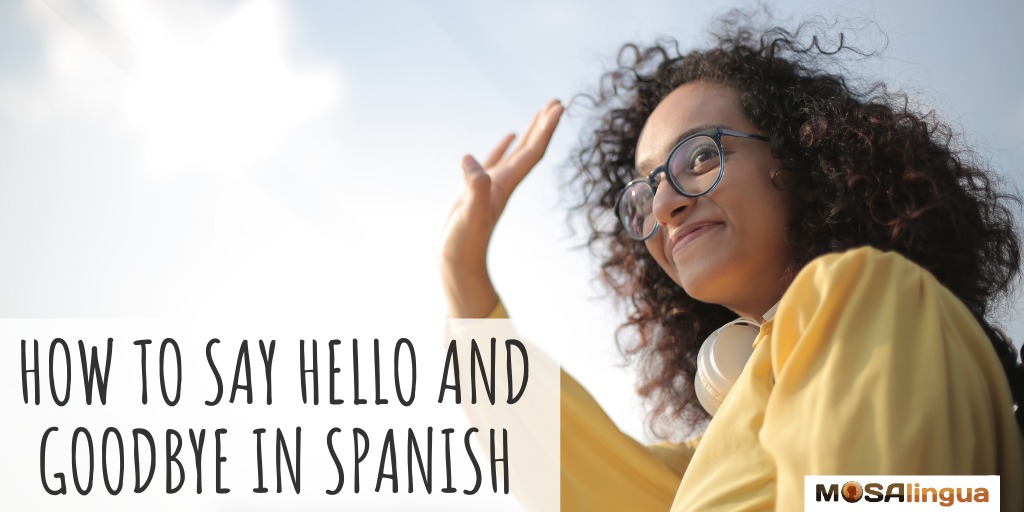¡Hola! Being able to say “Hello” and greet people properly is one of the first and most important steps to learning a new language. Like all other languages, including English, there’s more than one way to greet somebody in Spanish. Greetings can vary by formality, time of day, or special situations, like answering a phone. In this article, we’ll teach you all the most important and popular ways of saying Hello in Spanish, and when you should use each one.

Hola and Other Simple Ways to Say Hello in Spanish
It should come as no surprise that Hola and other simple greetings are among the most common and useful words in Spanish. After all, that’s how most conversations start! In Spanish, like other languages, there are a few different simple ways of greeting somebody. Some of them are best suited to more casual situations and others to more formal ones.
Start with hola
Hola can be used in both casual and formal settings, so it’s a safe way to start your greeting. And just like in English, if all you say is Hola, that’s OK (although it’s also considered polite to ask how somebody is doing). You can combine Hola with any of the more advanced greetings below. Just remember, the h is silent 😉
The root of the word Hola is unclear, and there are a few competing theories. One popular theory, which has today been abandoned due to lack of evidence, related it to the Muslim word Wallah (“I swear to God”). Muslim occupation of the Iberian peninsula (Spain and Portugal) lasted an impressive 781 years, from 711 to 1492, during which time Arab language, science, agriculture, and art dominated the region. Others believe it may come from the medieval German word holōn, meaning “to fetch” (especially when speaking to a ferryman), or old French holà! (“Whoa there!”). If you’re interested in Spanish etymology, you’ll want to find a good online Spanish-to-English dictionary – here are the ones we like best.
MosaTip: ¡Ey! Just like “Hey!” in English, Ey is a shortened form of hola and should only be used in a casual setting. Basically among friends, peers, and family members of the same age. It’s quick and easy, but not well-suited to formal settings. Definitely don’t start your next job interview with Ey! Be sure to read up on your Spanish slang and Latin American slang if you plan on using this greeting.
How to say hello in Spanish throughout the day
Of course, you can change up your greeting based on what time it is. Here are the most common Spanish greetings for each part of the day.
- Buenos días
This means “Good day” and can be used as a friendly or formal greeting up until about 1:00 pm or before lunchtime. It’s also used for “Good morning,” so you can use it as early as you like. While this and other greetings throughout the day are usually said in the plural (buenos días), you may occasionally hear buen día, in the singular. - Buenas tardes
Buenas tardes is used both for “Good afternoon” and “Good evening,” from after lunch or 1:00 pm up until dusk or dinner time, around about 7:00 pm or 8:00 pm. - and Buenas noches
Primarily a way to say hello in Spanish in the late evening or after nightfall, starting around 8:00 pm.- a greeting after nightfall or in the late evening, starting around 8:00 pm; and
- “Goodnight” when saying goodbye to somebody in the evening — this varies by region, though. Some prefer “Descansa” from the verb descansar, “to rest.”
MosaTip: ¡Buenas! Just like Ey, save this shortened version of the above three greetings for informal settings, among friends. You can use it at any time of the day, though!
Apretón de Manos and Dos Besos
In Spain, like in many Mediterranean and Latin cultures, greetings are typically accompanied by one of two actions: a kiss on each cheek (dos besos), or a handshake (apretón de manos). In actuality, the “kiss” on the cheek usually amounts to simply touching cheeks.
Traditionally, two men meeting each other will shake hands, unless they are good friends, in which case they may hug, or close friends or family members, in which case they may go for dos besos. If the greeting is between two women, a woman and a man, or children, it’s typical to see dos besos – a kiss on each cheek, starting from your left (their right).
Cultural shifts in the last few decades have blurred the lines, though — women meeting in a professional setting will typically shake hands, and some (but not all) members of the LGBT community often opt for dos besos in casual settings, regardless of who’s kissing whom. More women have also started to question the longstanding but intimate cultural practice of kissing a man on the cheek when meeting for the first time, especially in work settings.
If you’re not sure what to do, don’t worry! This is a very common learning curve for English speakers and others from cultures where kissing isn’t part of the standard greeting. The best way to learn the customs is to spend time in a Spanish-speaking country. Each region and country has its own customs, and it may take you a while to get used to dos besos – for many Americans, especially, it can seem a bit invasive, but it’s all part of the cultural experience.
Here’s a fun and informational article about dos besos etiquette.
Next Steps: Starting Conversations
Of course, you don’t have to limit yourself to a simple hola when saying hello to somebody in Spanish! Just like in English, there’s a whole slew of ways to ask how somebody is doing, and just as many ways to answer. Here are some of the most popular ones:
How to say “How are you?” in Spanish
Depending on who you’re speaking to and the setting, there are three different ways of saying “How are you?” in Spanish:
- ¿Cómo está?
This is a more formal way of asking how somebody is doing in Spanish. You should use this if you’re meeting somebody older than you or in a position of authority, or generally to show respect to somebody, like in a business meeting. If you want to go even more formal, use ¿Cómo está usted? - ¿Cómo estás?
This is the informal way of asking how somebody is doing, for friends and family, peers, classmates, and colleagues of the same age or younger.
MosaTip: Greeting more than one person? You can use ¿Cómo están? when speaking to more than one person in an informal setting, in all Spanish-speaking countries in the Americas. If you’re in Spain, though, you should use ¿Cómo estáis? for greeting multiple people in a formal settings. By the way, if you need some help conjugating irregular verbs like estar, head over to our mini guide to Spanish verbs.
Other casual questions
- ¿Qué tal? – “How’s it going?”
Most people consider it OK to use this in all but the most formal settings. In any event, it’s perfectly fine among friends, and easily one of the most common greetings in Spanish-speaking countries. Other informal variations include ¿Cómo andas?, ¿Cómo va?, and ¿Qué haces? When answering any of these questions, you can say:
-
- Bien, gracias, ¿y usted? – Good thanks, and you? (formal)
- Bien, gracias, ¿y tú? – Good thanks, and you? (informal)
- Todo bien – All is well
- Muy bien – Very well
- Aquí estamos, acá andamos – I’m okay, I’m getting by
- ¿Qué pasa? – “What’s up?” / “What’s happening?”
Use this when talking to friends and family, or somebody younger than you or of the same age in casual settings.
MosaTip: Not sure what counts as a “formal” or “informal” setting? No problem, it’s actually quite similar across cultures. Just think of when you would use, “What’s up?” You would definitely say it to your friends, maybe your parents or a boss you’ve worked with for a long time, but probably not at a job interview or when meeting somebody you highly respect. Would you say, “What’s happening?” to a doctor or lawyer? Probably not, so best to stick with ¿cómo está?
Other Greetings
Here are some other greetings you may find useful or fun!
- On the phone: When answering the phone, you can always say ¿Hola? You may also hear people answering the phone with ¿Sí? or ¿Diga?
- ¿Dónde has estado? – Where have you been?
- ¡Hace tiempo que no te veo! – I haven’t seen you in a while.
- Bienvenido(s)/a(s). – Welcome!
- Mi casa es su/tu casa. A popular phrase that’s made its way into English-speaking culture as well. “My house is your house” is the Spanish equivalent of “Make yourself at home,” to welcome visitors into your house. Careful, though, in some Spanish-speaking countries this phrase is said as more of a joke than a sincere welcome.
Saying Goodbye in Spanish
Alas, all good things, conversations included, must come to an end. When you’re ready to say farewell, use these popular Spanish goodbyes:
- Adiós – Goodbye
- Chau – Bye! (informal)
- Nos vemos – See you (informal)
- Hasta mañana / luego / la próxima semana / el próximo viernes – See you tomorrow / later / next week / next Friday.
And now it’s time for us to say ¡Hasta luego! I hope you liked this article about saying “Hello” in Spanish. You may also enjoy these articles:
- Our top Spanish phrases for beginners
- The 6 official languages of Spain and how to learn them
- How to say and describe colors in Spanish
- 10 must-know Spanish sentence starters and filler words to use once your conversation has gotten off the ground with one of the variations on “hello” in Spanish that you just learned.
Did we miss one of your favorite Spanish greetings, or maybe something specific to a given region? We’d love to hear about it! Feel free to leave us a comment below, and of course, don’t hesitate to ask if you have any questions.
Related posts:
Want to start improving your language skills today?
Improve your spoken Spanish

Good news: we have a course for that! The Speak Spanish with Confidence MasterClass.
It’s a comprehensive 8-module course designed to help you improve every aspect of your spoken Spanish – fluency, confidence, pronunciation, and more – step by step, and enjoy doing it.






Comments